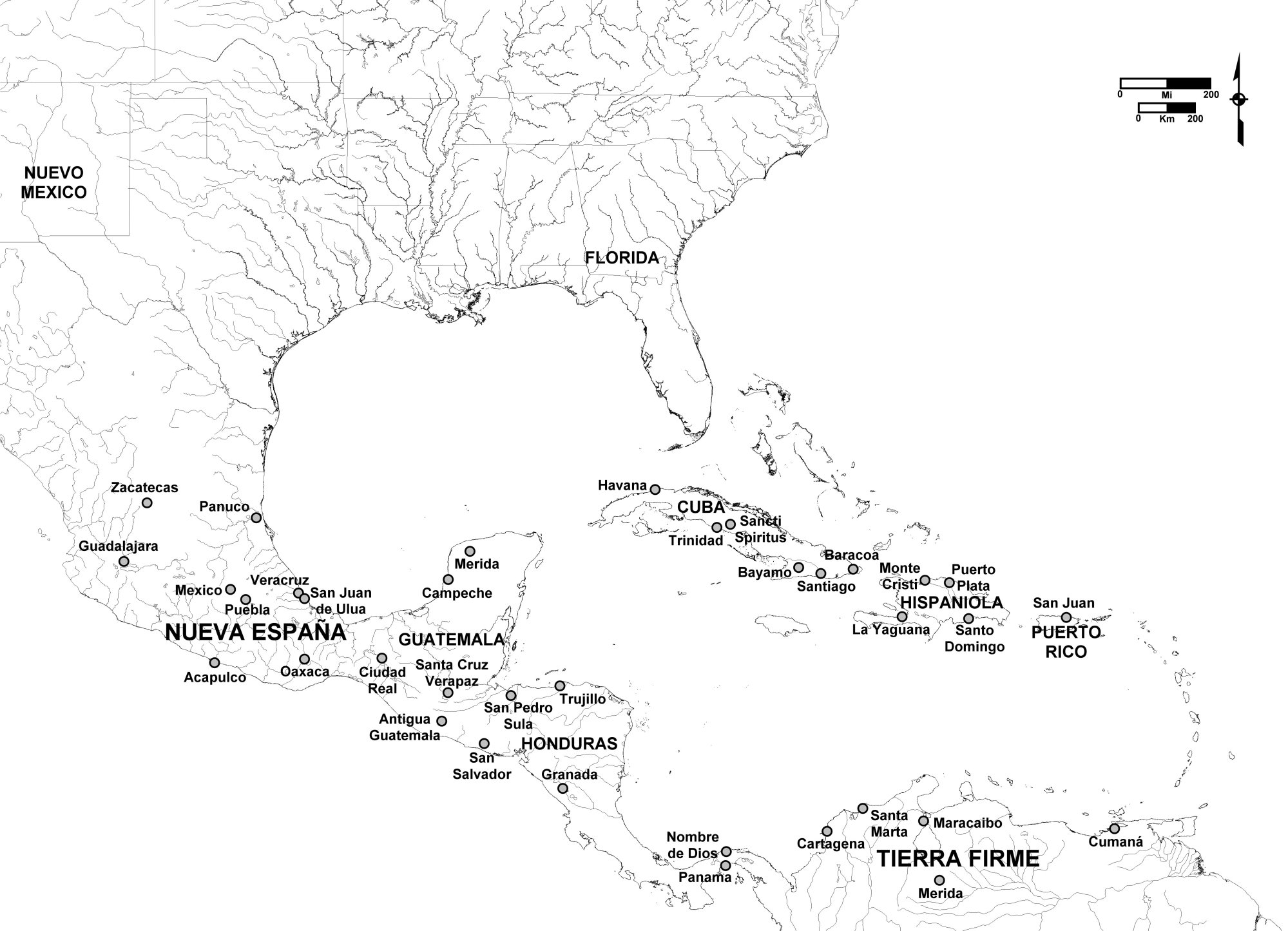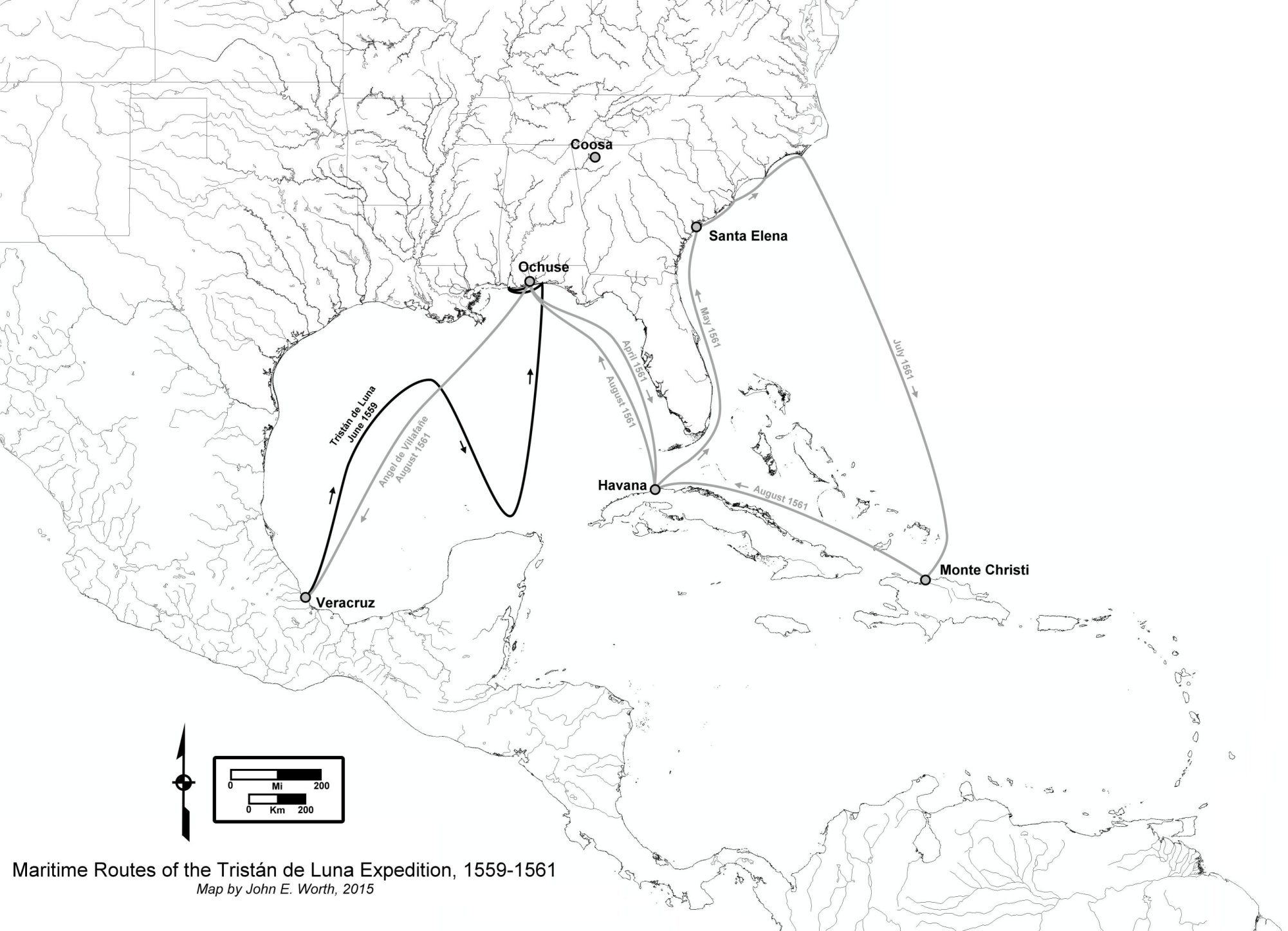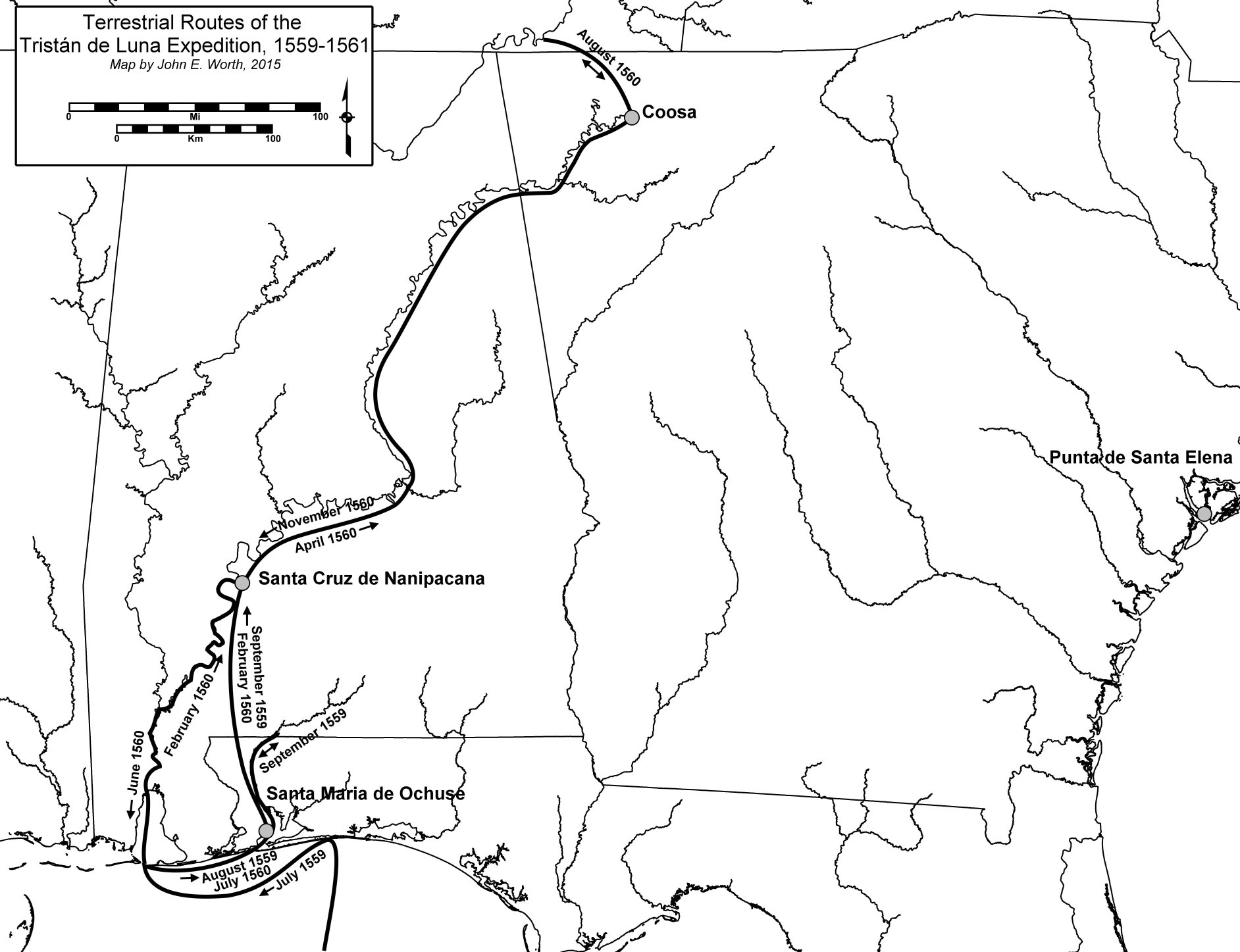The Tristán de Luna Expedition, 1559-1561
See also: Luna Participants / Luna Fleet / Luna Settlement / Luna Documents / Luna Bibliography
 As of 1559, Spain still had not established any substantial and lasting colonial presence in the Americas north of roughly the Tropic of Cancer. At minimum, this left an important and obvious vulnerability to Spanish fleets sailing from Havana to Spain, which followed the Gulf Stream along Florida's lower Atlantic coastline perilously close to unclaimed territory. The colonial expedition of Tristán de Luna y Arellano was therefore staged in New Spain (modern Mexico) in direct response to the Spanish crown’s desire to found a Spanish colony at the Punta de Santa Elena at modern Parris Island in Port Royal Sound, South Carolina, and by so doing block anticipated French colonization there. Luna’s expedition was instructed by Viceroy Luis de Velasco to establish a settlement at Pensacola, traverse the interior to establish a second settlement at the Indian province of Coosa in modern north Georgia, and then descend to Santa Elena where the final and principal settlement would be established.
As of 1559, Spain still had not established any substantial and lasting colonial presence in the Americas north of roughly the Tropic of Cancer. At minimum, this left an important and obvious vulnerability to Spanish fleets sailing from Havana to Spain, which followed the Gulf Stream along Florida's lower Atlantic coastline perilously close to unclaimed territory. The colonial expedition of Tristán de Luna y Arellano was therefore staged in New Spain (modern Mexico) in direct response to the Spanish crown’s desire to found a Spanish colony at the Punta de Santa Elena at modern Parris Island in Port Royal Sound, South Carolina, and by so doing block anticipated French colonization there. Luna’s expedition was instructed by Viceroy Luis de Velasco to establish a settlement at Pensacola, traverse the interior to establish a second settlement at the Indian province of Coosa in modern north Georgia, and then descend to Santa Elena where the final and principal settlement would be established.
Luna's expedition was the third formal attempt by Spain to establish a colonial settlement in Florida, following the two earlier short-lived settlements by Juan Ponce de León in 1521 (near Fort Myers, Florida) and Lúcas Vázquez de Ayllón in 1526 (near Brunswick, Georgia). Although there had been subsequent expeditions in Florida under Pánfilo de Narváez (1528), Hernando de Soto (1539-1543), and Fray Luis Cancer (1549), none of these actually established a colonial settlement intended to be permanent. Had the Luna expedition been successful, however, Spain would likely have prevented the 1562 French Charlesfort settlement at Santa Elena, and might never have even launched the 1565 colonial fleet of Pedro Menéndez de Avilés.
 On June 11, 1559, Luna's fleet departed the port of San Juan de Ulua in New Spain (at the modern city of Veracruz) with some 1,500 soldiers and other colonists, 240 horses, and well over a million pounds of food, bound for the shores of Florida at modern day Pensacola Bay. Sailing into the bay just over two months later on August 14, the fleet anchored and sent one ship back with news of their arrival, unloading people and equipment at the newly-established settlement over the next five weeks, but leaving the food on board ship in order to protect it until shelter could be built on shore. On September 19, a hurricane devastated the remaining ships at anchor, leaving only three afloat the next day. The chronology of the expedition over the next two years comprised an increasingly desperate attempt to keep the colonists alive after the destruction of their food stores, including four major maritime relief expeditions and the relocation of the majority of the colonists inland to the Indian town of Nanipacana along the Alabama River between February and July of 1560, as well as the dispatch of a 200-man detachment northward to the town of Coosa located in Northwest Georgia in search of food to ship downriver. After increasingly public disputes with his officers about whether or not to continue the expedition and move inland, Luna was ultimately replaced as governor in April 1561, followed by an unsuccessful maritime exploration of the Atlantic coast near Santa Elena under Luna's replacement Angel de Villafañe, and the withdrawal of the remnants of the Pensacola colony by August 1561. When the Viceroy gathered surviving leaders of the expedition in Mexico City the following March, the unanimous conclusion was to abandon the effort.
On June 11, 1559, Luna's fleet departed the port of San Juan de Ulua in New Spain (at the modern city of Veracruz) with some 1,500 soldiers and other colonists, 240 horses, and well over a million pounds of food, bound for the shores of Florida at modern day Pensacola Bay. Sailing into the bay just over two months later on August 14, the fleet anchored and sent one ship back with news of their arrival, unloading people and equipment at the newly-established settlement over the next five weeks, but leaving the food on board ship in order to protect it until shelter could be built on shore. On September 19, a hurricane devastated the remaining ships at anchor, leaving only three afloat the next day. The chronology of the expedition over the next two years comprised an increasingly desperate attempt to keep the colonists alive after the destruction of their food stores, including four major maritime relief expeditions and the relocation of the majority of the colonists inland to the Indian town of Nanipacana along the Alabama River between February and July of 1560, as well as the dispatch of a 200-man detachment northward to the town of Coosa located in Northwest Georgia in search of food to ship downriver. After increasingly public disputes with his officers about whether or not to continue the expedition and move inland, Luna was ultimately replaced as governor in April 1561, followed by an unsuccessful maritime exploration of the Atlantic coast near Santa Elena under Luna's replacement Angel de Villafañe, and the withdrawal of the remnants of the Pensacola colony by August 1561. When the Viceroy gathered surviving leaders of the expedition in Mexico City the following March, the unanimous conclusion was to abandon the effort.
 I have provided a few document extracts (in translated English and original Spanish), but to read much of the rest of the comparatively voluminous documentation from the Luna expedition, the two main published documentary sources about the expedition are available in electronic format, including Augustín Dávila Padilla's 1596 Historia de la Fundación y Discurso de la Provincia de Santiago de México de la Orden de Predicadores, por las vidas de sus varones insignes y casos Notables de Nueva España (pp. 189-229 for the Luna section; other editions available here), and Herbert Priestley's 1928 compilation of Spanish and English versions of many important documents called The Luna Papers, which has recently been reprinted with a new preface I wrote, and which is available in print or electronic form through the University of Alabama Press. Browsable scans of the original edition are also available free at the following links:
I have provided a few document extracts (in translated English and original Spanish), but to read much of the rest of the comparatively voluminous documentation from the Luna expedition, the two main published documentary sources about the expedition are available in electronic format, including Augustín Dávila Padilla's 1596 Historia de la Fundación y Discurso de la Provincia de Santiago de México de la Orden de Predicadores, por las vidas de sus varones insignes y casos Notables de Nueva España (pp. 189-229 for the Luna section; other editions available here), and Herbert Priestley's 1928 compilation of Spanish and English versions of many important documents called The Luna Papers, which has recently been reprinted with a new preface I wrote, and which is available in print or electronic form through the University of Alabama Press. Browsable scans of the original edition are also available free at the following links:
PALMM Florida version: The Luna Papers, v. I, and The Luna Papers, v. II.
Google Books version: The Luna Papers, v. I, and The Luna Papers, v. II.
A more complete bibliography of published sources relating to the history and archaeology of the Luna expedition is provided on a separate page.
Brief Chronology of the Luna Expedition
June 11, 1559
Luna fleet departs from San Juan de Ulua (Veracruz).
July 12, 1559
Fleet reaches coast of Florida at Santa Rosa Island near modern Navarre Beach.
late July, 1559
Accidentally passing the Bay of Ochuse (Pensacola Bay), fleet reaches Bay of Filipina (Mobile Bay), offloading surviving horses to travel by land back to Ochuse.
August 14, 1559
Fleet arrives at Bay of Ochuse (Pensacola Bay), selecting a site for settlement (christened Santa María de Ochuse) and offloading ships over the following 5 weeks.
September, 1559
Exploratory detachment of 100 men under 2 captains sent into the interior from Ochuse, one by land and the other by water up the Escambia River, returning after traveling 20 leagues in 20 days and arriving just after the hurricane.
September 19-20, 1559
Hurricane strikes fleet at Ochuse, destroying all but three vessels and most of the provisions.
September-November, 1559
Detachment of 200 men under 4 captains sent back into the interior from Ochuse, discovering a large Indian town called Nanipacana along the central Alabama River some 40 leagues inland, remaining there and sending word back to Ochuse.
September-October, 1559
Alonso Velásquez Rodríguez leads remaining ships to Havana to purchase relief supplies including livestock for the expedition at Ochuse.
December, 1559
First relief fleet arrives in Ochuse from San Juan de Ulua.
mid February, 1560
Luna and most of remaining colonists move inland by land and water from Ochuse to Nanipacana (christened Santa Cruz de Nanipacana), leaving 50-100 men at Ochuse.
mid March-early April, 1560
Luna sends detachment of 100 men in 4 boats upriver from Nanipacana, returning in 22 days after traveling 60-70 leagues along Alabama River.
April 15, 1560
Luna sends detachment of 200 men under Sergeant Major Mateo del Sauz upriver from Nanipacana to the Coosa province (near Calhoun, GA) in search of food.
June 24, 1560
After multiple petitions from starving soldiers and other colonists, Luna orders Nanipacana abandoned, and colonists descend to Mobile Bay.
late July, 1560
Luna’s colonists move from Mobile Bay back to Ochuse on Pensacola Bay; second relief fleet arrives in Ochuse 8 days later; some colonists are evacuated with returning fleet.
August 10, 1560
Luna dispatches 50-60 men in two frigates and a bark to sail to Havana and then to establish a temporary settlement at the Punta de Santa Elena (Parris Island, SC); expedition aborted in Cuba due to bad weather.
late August, 1560
Sauz detachment accompanies Coosa warriors in raid on rebellious Napochin province (near Chattanooga, TN).
about November, 1560
Sauz detachment returns to Ochuse from Coosa.
December, 1560
Third relief fleet arrives in Ochuse from San Juan de Ulua; more colonists are evacuated with returning fleet.
early April, 1561
Fourth relief fleet arrives under Angel de Villafañe, with orders from Viceroy to replace Luna as governor; Luna licensed to go to Spain, with most of remaining colonists taken by Villafañe to Havana, leaving only a detachment of 50 men at Ochuse.
May 27, 1561
After staging the expedition in Havana, Villafañe reaches Santa Elena, exploring northward before storms and the loss of 2 fragatas forces him to abandon the settlement.
late August, 1561
After returning to Hispaniola and Cuba, Villafañe's ship is blown off course to Campeche, where he learns that the remaining soldiers have been withdrawn from Ochuse, and he returns to San Juan de Ulua.